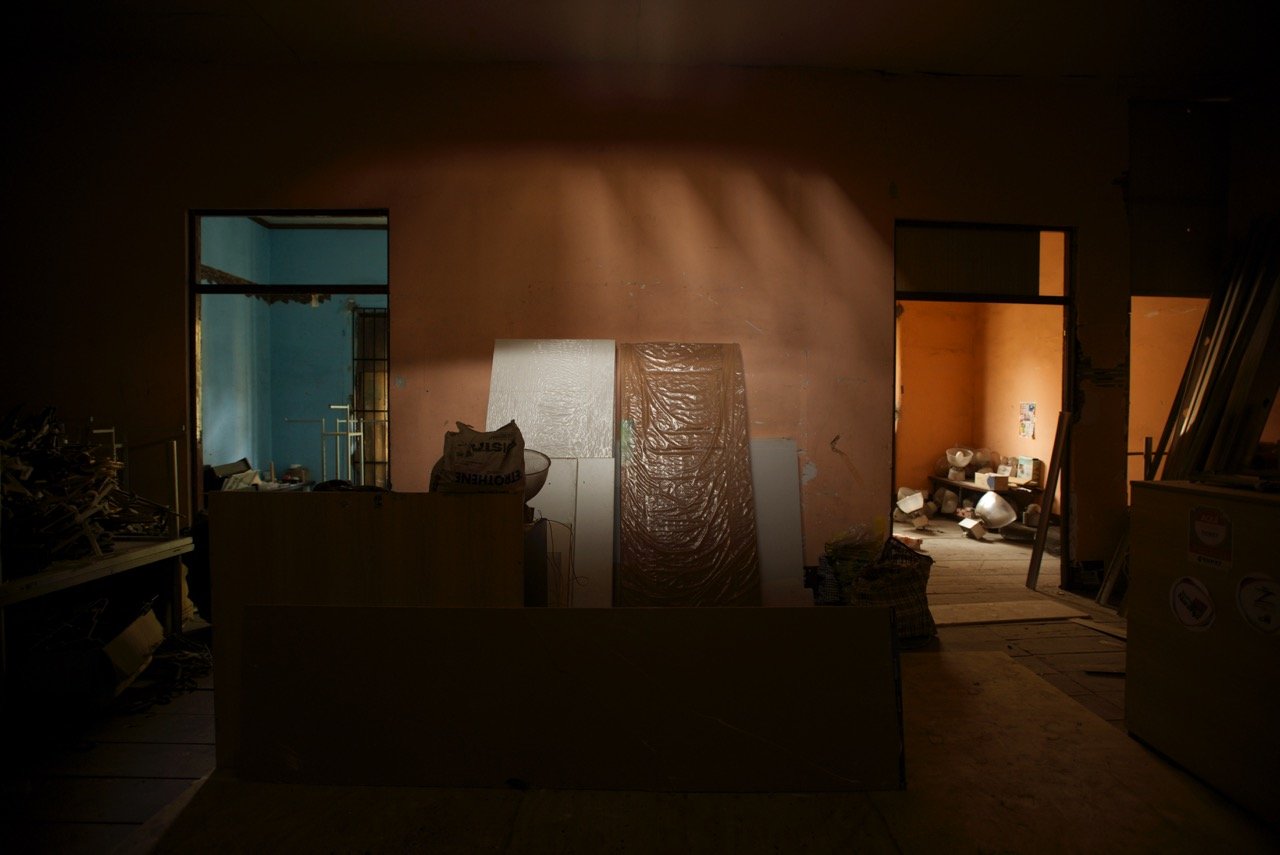Fotografía Central
Under layers of dust and disorder lay the ruins of what once was Eugène Courret’s Fotografía Central photographic studio. History does not stop; a cumbia song heard in the distance somehow explains this drastic transformation. Between 1935 and this December 2015 afternoon, Lima has changed in every possible way. The abandoned space is magical. To inhabit it again is a historical experience that surpasses me. Its broken thatch and cement walls reveal traces of the past; an old wall paper is exposed, inviting us to imagine what has been.
At home I see old pictures of the studio, I seek for information: the places where light would illuminate the subjects, the height of the ceilings and imagine the place.In the online archive of the National Library I find a picture of my greatgrandmother in her wedding dress and I understand that, somehow, a part of me was there.
Arturo Talavera arrives from Mexico to help me develop wet collodion pictures, an old photographic process also used by Courret in his studio. We work withnatural light, old cameras and chemicals we ourselves mix.
After four days, not a single picture has come out. Arturo, the expert, makestests to see if the problema is in the camera, the collodion, the silver nitrate or the fixative that we changed for cyanide. Or maybe it’s the darkroom, that lets in some light .
We move the darkroom to a more protected area and change all the chemicals, again. It seems that the silver nitrate is contaminated with dust particles. What we boil and snuck it to solve the problem. We work for fifteen days and the experience brings the evolution of photography to my mind. While I breathe beneath the fabric that I cover me with to see the inverted imagen in the camera, I start to understand photography better: Time and light, the image as true as that of a mirror. One hundred and fifty years have reduced exposure times, and our patience. History now has different parameters. After several tries, the pictures finally start to come out. The effort gives each photo a special value. I keep them all, flawed or not, since mistakes are part of the project.
I clean the glass, I pour the collodion, I sensitize the emulsion, I frame, expose, measure time and develop. Today, three months after completing the project, the ambrotypes, tintypes and negatives take me back, with their magical voices, to those December days. I wonder what would Courret think if he came back and saw what has become of his studio. He would stand on the balcony and be surprised at the way Jirón de la Unión looks, so different, with noise, lights and people of a Lima unknown to him. I think he'd run for his camera, as I did many times during those two weeks.
Astrid Jahnsen
THRESHOLD OF OBLIVION
Artist Astrid Jahnsen’s interest in the Fotografía Central photographic studio can be traced in several directions. Her interest in history –and the history of photography in particular–, is certainly one of them, but her love for the connection with the past that photography makes possible should also be mentioned (and, in that, a photograph of her great grandmother in her wedding dress taken in Fotografía Central plays a privileged role) as well as her awareness of the fact that, in Peruvian society, all things past are most of the times swiftly and easily deemed obsolete (something against which, you quickly learn when you meet her, she is determined to fight).
In Revelados, a different although related art project, Astrid Jahnsen seeks to bring back to life, albeit momentarily, some of the people who had their portrait taken in Fotografía Central, and allow them to take to the streets in an attempt to recover a lost memory. In the process of that project, the artist found herself with the possibility of entering the old studio to photograph it as it was at the end of 2015, 80 years after its closure.
It was certainly a liminal experience: Astrid used old photographic techniques –wet collodion glass plates that she made into negatives, ambrotypes and tintypes– to interrogate a space that was central to Peruvian photography and to the construction of identities and mindsets that marked the history of the country and now barely survive in some old family albums.
The old camera and photographic processes act as a threshold through which the artist looks at the present in search for traces of the past, but can only hint at a faded image of an era and a culture that lacks the capacity to be awed by its own past. Portrayed with these techniques, the ruins of Fotografía Central remind us of those old science fiction movies in which an anomaly in the space-time continuum allows the characters to peek, as through a veil, at the way time flows in another epoch.
The negatives, ambrotypes and tintypes taken by Astrid Jahnsen in what was Fotografía Central, this present-as-seen-through-the-veil-the-past, can tell us nothing of the dream world the backdrops and props of old photo studio helped generate; but in this vain attempt to rescue that world from the past, both melancholy and oblivion seem to give rise to a narrative that purports to be, paradoxically, the beginning of the abolition of oblivion itself.
Carlo Trivelli













